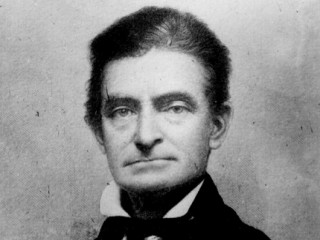
Brown, John biography
Date of birth : 1800-05-09
Date of death : 1859-12-02
Birthplace : Torrington, Connecticut
Nationality : American
Category : Famous Figures
Last modified : 2010-04-27
Credited as : American abolitionist, Captain Brown,
18 votes so far
President Abraham Lincoln said he was a "misguided fanatic" and Brown has been called "the most controversial of all 19th-century Americans". Brown's actions are often referred to as "patriotic treason", depicting both sides of the argument.
John Brown's attempt in 1859 to start a liberation movement among enslaved African Americans in Harpers Ferry, Virginia (now West Virginia) electrified the nation. He was tried for treason against the state of Virginia, the murder of five proslavery Southerners, and inciting a slave insurrection and was subsequently hanged. Southerners alleged that his rebellion was the tip of the abolitionist iceberg and represented the wishes of the Republican Party. Historians agree that the Harpers Ferry raid in 1859 escalated tensions that, a year later, led to secession and the American Civil War.
Brown first gained attention when he led small groups of volunteers during the Bleeding Kansas crisis. Unlike most other Northerners, who advocated peaceful resistance to the pro-slavery faction, Brown demanded violent action in response to Southern aggression. Dissatisfied with the pacifism encouraged by the organized abolitionist movement, he reportedly said "These men are all talk. What we need is action—action!" During the Kansas campaign he and his supporters killed five pro-slavery southerners in what became known as the Pottawatomie Massacre in May 1856, in response to the raid of the "free soil" city of Lawrence. In 1859 he led a raid on the federal armory at Harpers Ferry, Virginia (in modern-day West Virginia). During the raid, he seized the armory; seven people (including a free African American) were killed, and ten or more were injured. He intended to arm slaves with weapons from the arsenal, but the attack failed. Within 36 hours, Brown's men had fled or been killed or captured by local farmers, militiamen, and U.S. Marines led by Robert E. Lee. Brown's subsequent capture by federal forces, his trial for treason by the state of Virginia, and his execution by hanging in Charles Town, Virginia (now West Virginia) were an important part of the origins of the American Civil War, which followed sixteen months later.
When Brown was hanged after his attempt to start a slave rebellion in 1859, church bells rang, minute guns were fired, large memorial meetings took place throughout the North, and famous writers such as Emerson and Thoreau joined many Northerners in praising Brown.
Historians agree John Brown played a major role in starting the Civil War. His role and actions prior to the Civil War as an abolitionist, and the tactics he chose, still make him a controversial figure today. He is sometimes memorialized as a heroic martyr and a visionary and sometimes vilified as a madman and a terrorist. Some writers, such as Bruce Olds, describe him as a monomaniacal zealot, others, such as Stephen B. Oates, regard him as "one of the most perceptive human beings of his generation." David S. Reynolds hails the man who "killed slavery, sparked the civil war, and seeded civil rights" and Richard Owen Boyer emphasizes that Brown was "an American who gave his life that millions of other Americans might be free." For Ken Chowder he is "at certain times, a great man", but also "the father of American terrorism".
Brown's nicknames were Osawatomie Brown, Old Man Brown, Captain Brown and Old Brown of Kansas. His aliases were Nelson Hawkins, Shubel Morgan, and Isaac Smith. Later the song "John Brown's Body" (the original title of the "Battle Hymn of the Republic") became a Union marching song during the Civil War.
In 1938–1940, American painter John Steuart Curry created Tragic Prelude, a mural of John Brown holding a gun and a bible. In 1941, Jacob Lawrence illustrated the life of John Brown in The Legend of John Brown, a series of twenty-two gouache paintings. By 1977, the original paintings were in such fragile condition they could not be displayed, and the Detroit Institute of Arts commissioned Lawrence to recreate the series as a portfolio of silkscreen prints. The result was a limited edition portfolio of twenty-two hand-screened prints. The works were printed and published with a poem, John Brown, by Robert Hayden, which was commissioned specifically for the project. Though John Brown had been a popular topic for many painters, The Legend of John Brown was the first to explore the topic from an African American perspective.
On 16 October 1859, Brown led a raid on the federal armory at Harper's Ferry in Virginia, with a plan to arm the region's slaves and lead them in rebellion. Brown and his men seized the armory but were soon captured. Brown was hanged.
His death became a rallying point for anti-slavery forces and then for Union soldiers in the Civil War, who sang a marching tune called "John Brown's Body." ("John Brown's body lies a-mouldering in the grave. His soul is marching on!")
Extras : An "armory" is a stockpile of guns and ammunition. The tune of "John Brown's Body" is the same as the tune of "The Battle Hymn of the Republic." Julia Ward Howe wrote the "Battle Hymn" lyrics in 1861 after hearing "John Brown's Body". Author Stephen Vincent Benet also published a famous poem, titled John Brown's Body, about the raid. The federal troops who captured Brown were led by Robert E. Lee, later head of the Confederate Army during the Civil War.
















